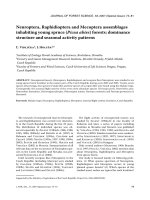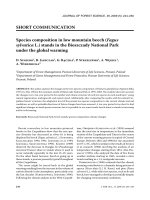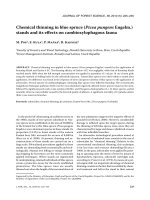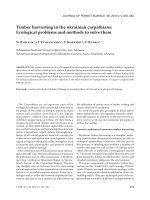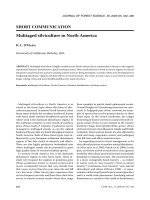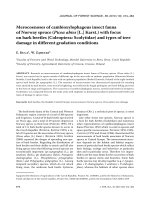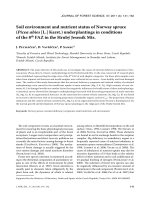Báo cáo lâm nghiệp: "Mineral nutrition in relation to the Norway spruce forest decline in the region Horný Spiš (Northern Slovakia)" docx
Bạn đang xem bản rút gọn của tài liệu. Xem và tải ngay bản đầy đủ của tài liệu tại đây (199.33 KB, 8 trang )
J. FOR. SCI., 53, 2007 (3): 93–100 93
JOURNAL OF FOREST SCIENCE, 53, 2007 (3): 93–100
e progressive massive decline of forest woody
plants, primarily spruce, spreading in the regions
Orava, Kysuce, Tatry and Spiš in recent years is a
well-recognised fact. Similarly affected stands can be
found in border regions in Poland and in the Czech
Republic, Germany and Italy. e general cause is
supposed to be a complex of adverse factors – long-
term impacts of airborne pollutants generated by
both local and remote foreign sources, low stability
of even-aged, spatially poorly differentiated conifer
monocultures, global climate change entailing an in-
crease in the mean air temperature and deficit of the
available soil water content, gradation of biotic pests,
primarily wood-destroying fungi and bark beetles,
etc. ese negative phenomena are accompanied by
changes in the chemistry of plant assimilatory tissues
and changes in soil chemistry.
Toxic substances dispersed in the atmosphere and
diluted in vertical and horizontal precipitation cause
damage especially to assimilatory tissues of forest
woody plants. ey impair the protective layer on
leaves and penetrate into the tissues from which
they leach Mg contained in chlorophylls, and other
biogenic elements, primarily K, Ca and P (
T et
al. 1996). Toxic substances in the environment also
decrease the potential synthesis of assimilates and
disturb the mechanism of leaf stomata control. In
such a way, they increase water losses followed by
Supported by Grant Agency of the Slovak Republic, Project No. 2/4159/04.
Mineral nutrition in relation to the Norway spruce forest
decline in the region Horný Spiš (Northern Slovakia)
Ľ. D
1
, J. K
2
, M. J
1
, J. V
1
1
Institute of Forest Ecology of the Slovak Academy of Sciences, Zvolen, Slovak Republic
2
Faculty of Forestry, Technical University Zvolen, Zvolen, Slovak Republic
ABSTRACT: In this contribution we present the results of analyses of selected mineral nutrients in assimilatory tissues
of spruce trees at different developmental phases (plants, adult trees) in the region Horný Spiš. e very close connec-
tion between mineral nutrient cycling and other physiological processes in the plants has been well recognised. e
presented analyses of mineral nutrient cycling were done within comprehensive eco-physiological research assessing
the physiology and health status of spruce stands in the study area. e research was conducted directly in the stand
(Hliníky locality, Horný Spiš – two research plots: 1. plot with spruce stand in advanced decline, 2. control plot – with-
out visible decline symptoms) and, at the same time as a pot experiment. e objective of the pot experiment was to
verify the supposed negative influence of soil environment (in the locality with advanced decline of spruce stands) on
the growth of spruce trees and their mineral nutrient conditions. e analyses of the material sampled from the stands
revealed high amounts of manganese (Mn
T
) that were in the toxicity range on both examined plots. Another negative
finding was high amounts of toxic aluminium, primarily in needles of adult trees growing on the plot with symptoms
of acute stand decline. is reflects a very low value of pH/H
2
O – 3.7 (pH/KCl – 3 to 2.8) and total exhaustion of the
soil suffering, moreover, from the lack of soil water. As for the differences in amounts of individual macronutrients
between the plot with intensive decline and the control plot, no significant differences were found, with the exception
of Fe. On the other hand, evident significant differences in risk elements Pb, Hg and Al were found. As for the differ
-
ences in nutrient contents in spruce seedlings in the pot experiment (variants 1 to 6), we can see significant differences
in macronutrient contents (N, P, Ca, K, Mn), in some cases also in risk element contents (Al).
Keywords: nutrition; Norway spruce; stress; spruce decline
94 J. FOR. SCI., 53, 2007 (3): 93–100
leaf drying. e changes in enzymatic activities are
progressive; the leaves are aging prematurely. e
result is lowered frost resistance of trees and distur-
bances in photosynthetic activities.
Today, it is possible to study the impact of min-
eral nutrition corresponding to different levels of
physiological structures and functions. However,
the function of nutrients is dependent on a number
of factors connected with tree growth, ontogenesis,
soil conditions and meteorology; consequently, to
meet the issue is frequently a really complex task. At
the same time, it is necessary to remember that the
various stress factors not only participate in changes
in the chemistry of tissues and cells, but also they
influence the tolerance or response of woody plants
(K et al. 1992; T, W
1999; Z et al. 2000).
Nutrient concentrations in conifer needles strong-
ly influence their biochemical capacity for photosyn-
thesis and growth, and they can also be reflected in
the leaf anatomy (J et al. 1998). Mineral nutri-
tion is indirectly coupled with stomatal frequency
and conductance, since every change in the tran-
spiration stream will also influence the transport of
nutrients to the foliage (B, V C 1992).
In this contribution we present the results of
analyses of selected mineral nutrients in spruce
assimilatory organs performed separately for the
different developmental phases (seedlings, young
trees – less than 20 years, adult trees) in the Horný
Spiš region, because the very close relation between
mineral nutrition and other physiological processes
is a well-recognised phenomenon.
e presented analyses of mineral nutrients were
carried out in the framework of a comprehensive
eco-physiological research assessing the physi-
ological and health status of spruce stands in the
geographic area concerned.
MATERIAL A METHODS
e Hliníky locality (Horný Spiš), in which re-
search was conducted, is situated in the region of the
Slovenské rudohorie Mts., the unit Volovské vrchy
Mts. In the territory of the Forest Management Unit
Spišská Nová Ves medium stable forest ecosystems
with the degree of ecological stability equal to 2 are
evidently dominant. e main cause of lower stabil-
ity is unfavourable species composition, secondarily
modified in favour of spruce. e natural conditions
in the area are not optimum for this woody plant due
to subnormal precipitation (precipitation shadow of
the High Tatra Mts.), and locally especially due to
lower altitudes with favourable conditions for devel-
opment of several generations of bark beetles in one
growing season. e experimental plot is situated at
950 m above sea level. It is a remnant of an 80-years
old homogeneous spruce stand, the major part of
which was cut in salvage cuttings enforced by bark
beetles calamities.
Research was conducted in the Hliníky local-
ity (Horný Spiš) on five selected adult spruce trees
(age of 100 years) on a plot exposed to air pollution
(advanced stage of spruce stand decline), and on
five sample trees on the control plot (without vis-
ible symptoms of decline until then). By the end of
September 2004, we sampled assimilatory tissues
from the branches of the fifth whorl in the upper
crown part. Simultaneously we also sampled the
material from a young spruce stand (age of 20 years,
five sample trees).
Changes in the physiological and, consequently,
health status of spruce trees were also studied in a
pot experiment established in the Arboretum Borová
hora. e aim of this experiment was to evaluate the
supposed negative influence of soil environment
(in a locality with advanced stage of spruce stand
dieback) on the growth of spruce trees and state of
mineral nutrition. We took the soil substrate for a
pot experiment from the plot with intensive spruce
dieback (almost decomposed spruce stand – Hliníky
locality, Horný Spiš). For comparison, we also took
the soil substrate from a beech stand in the same
area (without the influence of spruce needle litter).
At the same time, we selected several seedlings
from the air-pollution plot in the Hliníky locality
in two modifications − with symptoms of needle
yellowing and apparently green seedlings without
visible symptoms of depigmentation. The basic
standard for comparison were bare-rooted even-
aged seedlings from the tree nursery at Smižany
(Horný Spiš), registration number 043448-020 (age
1/2, class 20–25 cm).
e pot experiment had the following six vari-
ants:
– Spruce seedlings with visible symptoms of yellow
-
ing needles in the soil substrate from the air-pol-
lution plot Hliníky (10 seedlings);
– Spruce seedlings with symptoms of yellowing
needles in the soil substrate from the beech stand
(10 seedlings);
– Spruce seedlings, apparently green (without vi-
sible depigmentation of needles) in the soil sub-
strate from the air-pollution plot Hliníky (10 seed-
lings);
– Spruce seedlings, apparently green (without vis
-
ible depigmentation of needles) in the soil sub-
strate from the beech stand (10 seedlings);
J. FOR. SCI., 53, 2007 (3): 93–100 95
– Spruce seedlings from the tree nursery in the
soil substrate from the air-pollution plot Hliníky
(10 seedlings);
– Spruce seedlings from the nursery in the soil sub
-
strate from the beech stand (10 seedlings).
e primary goal of the pot experiment was to
study the influence of soil properties on the physi-
ological state of spruce seedlings and on the state of
mineral nutrition. e experiment was conducted
from 2004 to 2005.
e analysis of assimilatory tissues was focussed
on the quantification of amounts of N, S (NCS-
FLASH 1112 analyser), P, K, Ca, Mg, Mn, Fe, Al, Zn,
Cu, B (in the mineralised material using the method
AES-ICP), Ni, Cr, Cd, Pb (in mineralised material
using the method AAS-ETA) and Hg (in solid sam
-
ples, AMA 254).
Statistical analyses
We carried out statistical analyses of differences
in the studied elements between the plot with acute
symptoms of spruce stand decomposition and the
control plot (without apparent symptoms of dam-
age to the stand) and also between the individual
variants of the pot experiment. e applied method
was Mann-Whitney’s U Test, the calculations were
performed using statistics software (SAS Institute,
CA, USA).
RESULTS AND DISCUSSION
e extent of physiological damage to spruce trees
of various age categories in the area of Horný Spiš is
almost unambiguously consistent with the level of
mineral nutrition. We conducted our research, being
provided with a wide spectrum of data reported by
M (1997), B (1988), W
et al. (1989) and F and H (1985). It is
necessary to point out several important facts. High
contents of manganese (Mn
T
) reaching the range
of toxicity were found on both plots (Tables 2 and
4). Manganese is an essential element, it is however
toxic in higher concentrations. Its mobilisation in-
dicates disturbances of physiological equilibrium
reflected in the changed ratio of this element to iron
(originally 1:2 or 0.5). M et al. (1996) sug-
gested that among the studied parameters mainly
Mn content in spruce needles was correlated with
the needle loss. For this reason, the Mn content is
used as an indicator of damage to woody plants. In
such a way, the trace element becomes a toxic one.
Another negative finding is a high content of alu-
minium, primarily in needles of adult spruce trees on
the plot with acute symptoms of decomposing stands
(Tables 3 and 5). ese symptoms respond to a very
low pH/H
2
O value – 3.7 (pH/KCl – 3 to 2.8) and
overall soil exhaustion connected with the lack of
Table 1. Description of the research locality
Locality
Hliníky – Horný Spiš
region, Slovenské
rudohorie Mts.
Longitude 20°33´655´E
Latitude 48°56´646´N
Altitude 950 m a.s.l.
Aspect south-south-western
Forest enterprise ML – Spišská Nová Ves
Slope
10%
Topography moderate slope
Parent rock conglomerates
Soil Podzolic Cambisol
Mean annual temperature 6.8°C
Mean annual precipitation total 700 mm
Climate area moderately cold
Forest vegetation zone 5
Group of forest types Abieto-fagetum
Mean stand age 20 years
Species composition spruce 100%
Table 2. Contents of macronutrients (mg/kg in dry mass) in the needles of adult spruce trees growing on a plot with symptoms
of acute forest decline (Horný Spiš region, needle year-class: 2003)
Sample
tree
N S P Ca Mg K Fe Mn Zn B Cu
Sp 3 17,000 1,240 1,443 3,832 1,495 2,339 248 1,587 24.2 30.7 7.58
Sp 32 14,000 1,020 1,322 4,021 858 3,530 226 1,239 17.7 28.4 6.46
Sp 36 12,500 1,930 1,193 3,750 1,037 2,720 167 1,236 19.1 24.2 6.18
Sp 37 15,200 1,490 1,456 4,002 1,209 3,042 212 1,458 16.8 28.8 6.74
Sp 38 16,500 1,390 1,709 8,002 1,075 3,192 211 2,180 24.9 23.8 5.37
Average 15,040 1,414 1,425 4,721 1,135 2,965 213 1,587 20.5 27.2 6.47
St. dev. 1,839 338 191 1,837 237 455 30 388 3.76 3.03 0.81
s
–
x
823 151 86 822 106 204 13 173 1.68 1.36 0.36
96 J. FOR. SCI., 53, 2007 (3): 93–100
soil water. e rapid decomposition of adult spruce
stands is also promoted by low contents of basic
cations (primarily potassium and partially calcium)
that are not sufficient for the compensation of toxic
influences of manganese and mainly of aluminium.
e low content of potassium also indicates the
insufficiency of water regimen both in soil and in
individual spruce trees. e generally hypothesised
deficiency of magnesium and increased heavy metal
contents in needles of spruce trees growing in the
region Horný Spiš were not however confirmed.
As for the differences in individual macronutrients
between the plot affected by intensive decline and
the control plot, we can conclude that, except for
Fe-content, there were not found any significant dif-
ferences between the two plots. On the other hand,
there are evident significant differences between
the studied plots in Pb, Hg and Al (Table 6, Mann-
Whitney’s U Test).
We carried out the pot experiment with the objec-
tive to confirm the supposed negative influence of
soil environment, and certain soil exhaustion (in a
locality with advanced stage of spruce stand decline)
on the growth of spruce trees and contents of min-
eral nutrients.
As for the differences in element contents in
needles of spruce seedlings in the pot experiment
(variants 1 to 6), we can see significant differences
in macronutrients (N, P, Ca, K, Mn), in some cases
also in risk elements (Al).
Significant differences in the content of N were
mostly indicated when spruce seedlings taken from
the acutely decomposing stand were planted in the
soil taken from the same plot – compared with vari-
ants when the spruce seedlings were planted in the
soil taken from the beech stand (without the influ-
ence of spruce litter) (variants 1–6, 2–3, 3–4, 3–6,
Table 7).
e role of N in physiological processes, mainly
photosynthesis, is commonly well recognised be-
cause changes or differences in the level of nitrogen
nutrition are mostly reflected in changes in the struc-
ture and function of the photosynthetic apparatus
(lowered efficiency of utilisation of photosyntheti-
cally active radiation).
Similarly, we recorded significant differences in
another macroelement Ca, primarily in those vari-
ants of the experiment in which we compared the
seedlings planted in the soil with intensive impact
of spruce litter and the seedlings planted in the sub-
strate from the beech stand (without the influence
of acid litter).
In the case of P and K we observed significant dif
-
ferences between variants 5 and 6 (5 – spruce seed
-
Table 3. Contents of risk elements (mg/kg in dry mass) in the needles of adult spruce trees growing on a plot with symptoms
of acute forest decline (Horný Spiš region, needle year-class: 2003)
Sample tree Ni Pb Cd Hg Cr Al
Sp 3 < 0.20 1.48 0.048 0.056 0.282 274
Sp 32 3.18 1.88 0.096 0.063 0.119 239
Sp 36 3.73 1.99 0.105 0.061 0.157 214
Sp 37 4.42 0.86 0.034 0.054 0.209 262
Sp 38 1.07 2.11 0.068 0.063 0.404 217
Average 2.52 1.66 0.070 0.059 0.234 241
St. dev. 1.80 0.508 0.030 0.004 0.113 27
s
–
x
0.81 0.227 0.014 0.002 0.050 12
Table 4. Contents of macronutrients (mg/kg in dry mass) in the needles of adult spruce trees growing on a plot without
symptoms of acute forest decline (Horný Spiš region, needle year-class: 2003)
Sample tree N S P Ca Mg K Fe Mn Zn B Cu
Sp 3 19,500 1,830 1,063 3,147 915 2,385 65.50 1,915 11.90 22.30 3.80
Sp 32 15,800 1,110 1,349 5,685 1,147 2,962 165.00 3,055 33.30 23.60 6.03
Sp 36 17,900 1,620 1,298 7,188 1,812 2,091 73.60 3,508 29.10 34.20 4.67
Sp 37 18,000 1,680 1,254 4,232 977 2,745 70.90 3,182 14.70 23.50 4.00
Sp 38 12,000 890 1,608 6,538 1,621 2,930 89.50 3,445 27.50 37.90 5.13
Average 16,640 1,426 1,314 5,358 1,294 2,623 92.90 3,021 23.30 28.30 4.73
St. dev. 2,909 404 197 1,659 400 375 41.28 646 9.42 7.21 0.90
s
–
x
1,301 181 88 742 179 168 18.50 289 4.21 3.23 0.40
J. FOR. SCI., 53, 2007 (3): 93–100 97
lings from the forest nursery planted in the substrate
from the declining forest stand, 6 – spruce seedlings
from the nursery planted in the soil substrate from
the beech stand).
An unfavourable situation in the content of Mn
(limit-exceeding values in adult spruce trees in both
localities) was also observed for spruce seedlings in
the pot experiment (the limit values were exceeded
many times). Significant differences were confirmed
again, primarily in those variants of the pot experi-
ment in which we compared yellowing spruce seed-
lings planted in the soil with intensive impact of
spruce litter and green spruce seedlings planted in
the soil from the beech stand (Table 8).
We observed significant differences in risk element
contents, mainly for Al, between the variants when
both yellowing and green seedlings were planted in
the soil from the decomposing stand and compared
with both yellowing and green seedlings planted in
the soil from the beech stand (Table 8).
Phenomena of decline in two spruce (Picea abies
[L.] Karst.) forests in different locations in Austria
were described on a biochemical and ultrastructural
level by T et al. (1996). ey established that ni-
trogen, calcium, and potassium contents of the nee-
dles were significantly correlated with chlorophyll
concentrations in visibly yellowed needles (from
declining trees with more than 40% needle loss and
visible needle chlorosis). In the other locality (appar-
ently healthy trees with less than 40% needle loss)
nutritional factors did not seem to play a dominant
role in the initial stages of needle yellowing.
Most studies concerning the interaction of pol-
lutant stresses and mineral nutrient concentrations
reported effects on plant growth and yield (P et
al. 1994; T, W 1999; E 2005).
K and S (1994) studied relationships between
symptoms expressed by Norway spruce foliar and
soil elemental status. They found out that foliar
concentrations of Mg, Ca, K, P, Mn, Pb and Zn were
positively correlated with concentrations of corre-
sponding soil elements. Principal component regres-
sion analysis of the data provided an assessment of
interactions and balances among foliar elements, and
among soil elements and their possible influences on
crown symptoms (crown discoloration and crown
Table 5. Contents of risk elements (mg/kg in dry mass) in the needles of adult spruce trees growing on a plot without symptoms
of acute forest decline (Horný Spiš region, needle year-class: 2003)
Sample tree Ni Pb Cd Hg Cr Al
Sp 3 2.360 0.840 0.071 0.042 0.102 133
Sp 32 < 0.200 0.500 0.063 0.045 0.182 185
Sp 36 2.790 0.730 0.096 0.040 0.092 153
Sp 37 2.300 0.220 0.061 0.041 0.156 128
Sp 38 2.730 0.770 0.115 0.040 0.093 160
Average 2.080 0.610 0.081 0.042 0.125 152
St. dev. 1.071 0.041 0.023 0.254 0.041 23
s
–
x
0.480 0.019 0.010 0.113 0.019 10
Table 6. Significance of differences in element contents in spruce needles (adult trees) between the declined and control spruce
forest
Nutrients Sample size Significance level Risk elements Sample size Significance level
N
5 0.3095 Ni 5 0.4206
S 5 1.0000 Pb 5 0.0079**
P 5 0.4206 Cd 5 0.5476
Ca 5 0.5476 Hg 5 0.0079**
Mg 5 0.6905 Cr 5 0.0556
K 5 0.3095 Al 5 0.0079**
Fe 5 0.0079**
Mn 5 0.0158*
Zn 5 0.6905
B 5 0.6904
Cu 5 0.0158*
Mann-Whitney’s U Test, *P < 0.05, **P < 0.01
98 J. FOR. SCI., 53, 2007 (3): 93–100
defoliation). e knowledge of nutrient deficiency
ranges may help diagnose foliar symptoms, but their
exclusive use may overly simplify relationships be-
tween foliar symptoms and foliar elements.
CONCLUSION
Study of changes in the plant tissue chemistry
is an important component of eco-physiological
analyses. It contributes significantly to evaluation of
the physiological and, consequently, health status of
forest stands.
e results of analyses of mineral nutrient contents
in assimilatory tissues of spruce stands allow us to
conclude that the mineral nutrition of spruce trees
growing in the region Horný Spiš is considerably
disturbed. is is evident from high contents of
manganese and aluminium and low contents of cal-
cium and primarily potassium in spruce assimilatory
tissues. At the same time, certain exhaustion of the
Table 7. Significance of differences in element contents (N, S, P, Ca, Mg) in spruce needles between the variants in a pot
experiment
Variants Sample size I Sample size II N S P Ca Mg
1–2 8 8 0.0379* 0.5737 0.1949 0.0499* 0.1605
1–3 8 6 0.6216 0.1419 0.6620 0.0593 0.1079
1–4 8 10 0.1457 0.2743 0.2743 0.1220 0.6334
1–5 8 10 0.1672 0.8968 0.0434* 0.1011 0.8286
1–6 8 9 0.0152** 0.0927 0.9626 0.0006** 0.3704
2–3 8 6 0.0016** 0.2824 0.3450 0.0047** 0.4136
2–4 8 10 0.5148 0.8968 0.8968 0.6334 0.4082
2–5 8 10 0.8148 0.7618 0.0434* 1.0346 0.5148
2–6 8 8 0.2766 0.6058 0.0274* 0.1388 0.1388
3–4 6 6 0.0193** 0.6354 0.3676 0.0017** 0.1179
3–5 6 6 0.0420* 0.2198 0.0160* 0.0009*** 0.0727
3–6 6 6 0.0009*** 0.6889 0.5287 0.0004*** 0.0120*
4–5 10 10 0.9682 0.5787 0.0753 0.9705 0.7959
4–6 10 10 0.2775 0.7802 0.0653 0.0947 0.5490
5–6 10 10 0.6665 0.4002 0.0006*** 0.2110 0.4002
Mann-Whitney’s U Test, *P < 0.05, **P < 0.01
Table 8. Significance of differences in element contents (K, Fe, Mn, Zn, Al) in spruce needles between the variants in a pot
experiment
Variants Sample size I Sample size II K Fe Mn Zn Al
1–2 8 8 0.0830 0.7984 0.0002** 0.5054 0.0046**
1–3 8 6 0.4908 0.8518 0.6620 0.7546 0.0593
1–4 8 10 0.1220 0.0434* 0.0005** 0.9654 0.0008**
1–5 8 10 0.8968 0.9654 0.3599 0.6334 0.8286
1–6 8 9 0.0206* 0.0274* 0.0001** 0.5414 0.0001**
2–3 8 6 0.2284 0.9497 0.0007** 0.8518 0.0593
2–4 8 10 0.5148 0.2743 0.5148 0.8968 0.9654
2–5 8 10 0.0117* 0.6334 0.0002*** 0.3154 0.0205*
2–6 8 8 1.0374 0.2359 0.2359 0.6730 0.4807
3–4 6 6 0.4278 0.5622 0.0017 0.6354 0.0109**
3–5 6 6 0.2198 0.6354 0.4278 0.7128 0.4278
3–6 6 6 0.0879 0.6070 0.0008*** 0.2721 0.0004**
4–5 10 10 0.0753 0.0753 0.0001*** 0.4359 0.0089**
4–6 10 10 0.7197 0.9682 0.6038 0.5490 0.0349*
5–6 10 10 0.0076** 0.0435* 0.0001*** 0.1333 0.0002***
Mann-Whitney’s U Test, *P < 0.05, **P < 0.01
J. FOR. SCI., 53, 2007 (3): 93–100 99
soil exploited by several generations of spruce stands
alien to the area is also evident.
R efe r ence s
BERGMANN W., 1988. Ernährungsstörungen bei Kultur-
pflanzen. Enstehung, visuelle und analytische Diagnose.
Jena, VEB Gustav Fischer Verlag: 762.
BONAN G.B., VAN CLEVE K., 1992. Soil temperature, ni-
trogen mineralization, and carbon source-sink relationship
in boreal forests. Canadian Journal of Forest Research, 22:
629–639.
EWALD J., 2005. Ecological background of crown condition,
growth and nutritional status of Picea abies (L.) Karst. in
the Bavarian Alps. European Journal of Forest Research,
124: 9–18.
FIEDLER H.J., HÖHNE H., 1985. Mengen und Spurenele-
mentgehalt der Eibennadeln und Fichtennadeln in Abhän-
gigkeit von biologischen und standortkundlichen Faktoren.
In: Mikronährstofforschung. Pflanzenernährung Jena,
Publishers Indy: 29–31.
JOKELA A., SARJALA T., HUTTUNEN S., 1998. e struc-
ture and hardening status of Scots pine needles at different
potassium availability levels. Trees, 12: 490–498.
KATZENSTEINER K., GLATZEL G., KAZDA M., STERBA
H., 1992. Effects of air pollutants on mineral nutrition of
Norway spruce and revitalization of declining stands in
Austria. Water, Air, and Soil Pollution, 61: 309–322.
KE J., SKELLY J.M., 1994. Relationship between symptoms
expressed by Norway spruce and foliar and soil elemental
status. Water, Air, and Soil Pollution, 74: 289–305.
MAŇKOVSKÁ B., 1997. Concentrations of nutritional and
trace elements in spruce and beech foliage as an environ-
mental indicator in Slovakia. Lesnictví, 43: 117–124.
MARKET B., HERPIN U., MAŇKOVSKÁ B., 1996. A compar-
ison of heavy metal deposition in select Eastern European
countries using the moss monitoring method, with special
emphasis on the “Black triangle”. Science Total Environ-
ment, 193: 85–100.
PFANZ H., VOLLRATH B., LOMSKÝ B., OPPMANN B.,
HYNEK V., BEYSCHLANG W., BILGER W., WHITE M.
V., MATERNA J., 1994. Life expectancy of spruce needles
under extremely high air pollution stress: performance of
trees in the Ore Mountains. Trees, 8: 213–222.
TAUSZ M., ZELLNIG G., BERMADINGER-STABENTHEI-
NER E., GRILL D., KATZENSTEINER K., GLATZEL G.,
1996. Physiological, structural, and nutritional parameters
of Norway spruce needles from declining forest stands
in Austria. Canadian Journal of Forest Research, 26:
1769–1780.
TRIMBACHER C., WEISS P., 1999. Needle surface character-
istics and element contents of Norway spruce in relation to
the distance of emission sources. Environmental Pollution,
105: 111–119.
WEIKERT R.M., WEDLER M., LIPPERT M., SCHRAMEL
P., LANGE O.L., 1989. Photosynthetic performance, chlo-
roplast, pigments and mineral content of various needle
age classes of spruce with and without the new flush: an
experimental approach for analysing forest decline phe-
nomena. Trees, 3: 161–172.
ZIMMERMANN F., OPFERMANN M., BAUCKER E., FIE-
BIG J., NEBE J., 2000. Nutrition-physiological responses
of spruce to different levels of sulphur dioxide stress in the
Erzgebirge Mountains and the uringian Forest, Germany.
Forstwissenschaftliches Centralblatt, 119: 193–207.
Received for publication July 27, 2006
Accepted after corrections October 9, 2006
Minerálna výživa vo vzťahu k odumieraniu smreka v oblasti Horného Spiša
(severné Slovensko)
ABSTRAKT: V rámci príspevku uvádzame výsledky analýz vybraných prvkov minerálnej výživy asimilačných orgánov
smreka v rôznych vývojových štádiách (sadenice, dospelé jedince) v oblasti Horného Spiša, nakoľko je všeobecne
známa veľmi úzka previazanosť minerálnej výživy i ostatných fyziologických procesov. Prezentované analýzy mine
-
rálnej výživy sú súčasťou komplexného ekofyziologického výskumu, v rámci ktorého bol hodnotený fyziologický
a následne i zdravotný stav smrekových porastov v danej oblasti. Časť výskumu bola realizovaná priamo v poraste
(lokalita Hliníky, Horný Spiš – 2 výskumné plochy, prvá plocha s pokročilým stupňom rozpadu smrekového porastu,
druhá plocha kontrolná – bez viditeľných známok rozpadu porastu) a časť prostredníctvom nádobového experi-
mentu. Cieľom nádobového experimentu bolo zistiť predpokladaný negatívny vplyv pôdneho prostredia (na lokalite
s pokročilým stupňom odumierania smrekových porastov) na rast smreka i stav minerálnej výživy. V rámci analýz
vzoriek z porastu boli zistené vysoké obsahy mangánu (Mn
T
), ktoré sa pohybujú v oblasti toxicity, a to na obidvoch
100 J. FOR. SCI., 53, 2007 (3): 93–100
Corresponding author:
RNDr. Ľ D, Ph.D., Ústav ekológie lesa SAV, Štúrova 2, 960 53 Zvolen, Slovenská republika
tel.: + 421 455 320 313, fax: + 421 455 479 485, e-mail:
skúmaných plochách. Ďalším negatívnym zistením sú vysoké obsahy toxického hliníka, zvlášť v ihliciach dospelých
smrekov na ploche s akútnymi príznakmi rozpadu porastu. Je to odraz veľmi nízkeho pH/H
2
O – 3,7 (pH/KCl – 3 až
2,8) a celkového vyčerpania pôdy spolu s nedostatkom pôdnej vody. Čo sa týka rozdielov v obsahu jednotlivých
makroživín medzi plochou postihnutou intenzívnym rozpadom a kontrolnou plochou, môžeme konštatovať, že až
na obsah Fe neboli zistené významné rozdiely medzi plochami. Na druhej strane pri porovnaní obsahu rizikových
prvkov sú medzi sledovanými plochami zjavné signifikantné rozdiely u Pb, Hg a Al. Čo sa týka rozdielov v obsahu
elementov v ihliciach sadeníc smreka v rámci nádobového pokusu (varianty 1 až 6), môžeme konštatovať, že boli
zistené významné rozdiely jednak na úrovni makroživín (N, P, Ca, K, Mn), jednak v niektorých prípadoch i na úrovni
obsahu rizikových prvkov (Al).
Kľúčové slová: minerálna výživa; smrek; stres; odumieranie smreka
